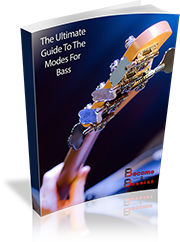Bass Modes
When I was first starting out, one of the biggest hurdles for me was starting to learn the modes on bass. People could kind of explain them to me – they kind of made sense, I could see the shapes – but it was still confusing.
Some people even told me not to learn them; that as a bass player, I didn’t need the modes. But I was too determined (or maybe just stubborn) to give up.
Eventually, I had a sort of epiphany. At last, I could see how everything was related and how it all fit together. But getting to that point took some time – a lot more time than I would have liked.
So my goal for you in this lesson is to nudge you towards your own epiphany, but a little bit faster than I had mine. I’ll make things as clear as possible for you using simple, easy-to-understand terms.
When you do have your epiphany, you’ll know exactly what to play over almost anything, and be guaranteed to sound good! Dodgy notes will be a thing of the past and you won’t have to wonder if you’re playing the ‘right’ thing. You’ll know in advance.
Video Not Showing Up Here? Watch On YouTube

Stop Struggling With The Modes On bass
FREE - Download the 16-page Ultimate Guide To The Modes Of The Major Scale For Bass and:
- Get a full explanation of the modes in simple, easy-to-understand terms
- Discover how the modes REALLY work and how they're related to different chords
- Learn how to use the modes, and where you can use each of them
- Download the free PDF guide plus 24 practice tracks that will have you using the modes TODAY
Do you see? The modes are not nearly as complicated as you might think. The modes are just ‘versions‘ of the major scale. They’re all related to that ‘parent‘ major scale. Simple, right?
Don’t let the fancy Greek names fool you. It’s really quite simple. Each key follows the exact same structure – Ionian is always the first mode, then Dorian, Phrygian etc.
However, this doesn’t answer the question of how or where you can use the modes. The answer has to do with chords and something called a ‘chord-scale‘. If you want the full picture, go ahead and download The Ultimate Guide To The Modes For Bass.
Inside it, you’ll learn how exactly where to use each of your modes. There’s even a cheat sheet that tells you which modes to use no matter what key you’re in. You can also download 24 practice tracks that you can use to start practicing your modes today.
Good luck with the lesson and happy playing!
Cheers,



Thank you for accepting me as one of your leaners.
Hi
Quick question. If using one of the C modes, eg Dorian, is the root tone C or D?
Hey Eric – good question! If you’re talking about ‘C modes’ as the modes from C major, then the D would be D Dorian because it’s the 2nd note (and mode) in the key of C major. Even though you’re using notes from C major, because the first note of the mode is D, you’d call it D Dorian.